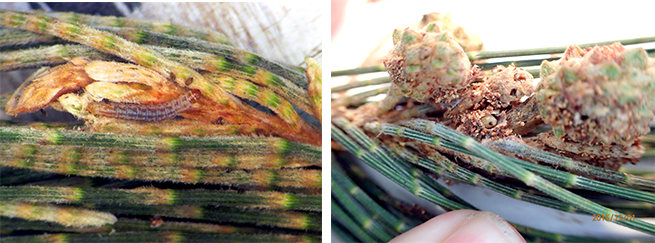Evaluating Biological Control Agents of Australian Pine
Three species of Australian pine, or Casuarina species, are fast growing evergreen trees that have become serious invasive weeds of agricultural, urban and coastal areas in the United States especially in Arizona, California, Florida, Hawaii and Texas.
With high reproduction, these trees can rapidly colonize disturbed agricultural areas, along seashores and on barrier islands where they threaten endangered sea turtles and American crocodiles. Australian pine was widely planted for agriculture before the 1920s as windbreaks surrounding citrus orchards and other commodities and in the 1950s and 1960s for shade in urban and regional parks.
With their shallow root system, they can be extremely dangerous as they are prone to fall during extreme wind events and cause economic damage to agriculture, homes and businesses. Australian pine trees quickly become the tallest trees in the canopy, and they produce thick blankets of leaves that leach toxic substances preventing the germination of other plants. When the trees flower, people suffer from allergic reactions to the abundant amounts of pollen produced seasonally.

To decrease the density of these Australian pine species, USDA ARS Australian Biological Control Laboratory (ABCL) staff are searching for safe and effective biological control agents in the native range of these trees in Australia. ABCL staff work closely with Greg Wheeler from the USDA ARS Invasive Plant Research Laboratory in Fort Lauderdale, Florida. Australian surveys discovered insect herbivores that attack the foliage, flowers and fruit which reduces the vigor and reproduction of Australian pine. Targeting reproduction as well as immature seedlings and saplings would reduce the spread of these trees into new areas.

The most damaging insect herbivores have been prioritized and currently under evaluation includes a gall forming Selitrichodes wasp and fruit and leaf feeding Carposinidae and Gelechiidae moths. Relatives of the wasp are very damaging to Australian pine in Guam and attack mature trees and saplings. The moth larvae feed on developing seed pods and growing tips and are a high priority due to their dual mode of feeding.
Testing seed feeders alone, such as the wasp, Bootanelleus orientalis, is problematic as plants maintained in the laboratory for rearing and testing are not mature enough to produce fruit. Several other defoliating xyloryctid and noctuid moth species have already been evaluated. Prospects for control of these invasive trees are promising and prioritized agents will eventually be shipped from Australia to stateside quarantine prior to being petitioned for release in the United States if found to be sufficiently specific and impactful.

Contact: Matthew Purcell
USDA ARS Australian Biological Control Laboratory (ABCL) is based at the Ecosciences Precinct in Brisbane, Australia, and is administered through a Specific Cooperative Agreement between ARS and Australia’s Federal research body, the Commonwealth Scientific and Industrial Research Organisation (CSIRO). The agreement has been a very productive, mutually beneficial, long-term collaborative relationship originating in 1985. Assisting with solving U.S. problems is reciprocated by ARS through supplying Australian scientists with biological control agents from the America’s to control invasive weeds in Australia.
